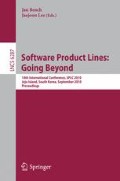Abstract
In software product line engineering (SPLE), feature modeling has been extensively used to represent commonality and variability between the products of a domain in terms of features, based on which reusable components are developed. However, the link between a feature model and product requirements, that fundamentally decide how the features are developed into reusable components, has not been adequately addressed in SPLE methods. This paper introduces an approach to combining feature modeling and problem frames in an attempt to address this problem. First, features are mapped to problem frames using heuristics derived from feature modeling and feature mapping units. Requirements are then identified and analyzed to ensure that they are fully satisfied. Finally, a solution modeling method maps the problem frames to architectural components. A Home Integration System (HIS) case study is used to demonstrate the feasibility of the approach.
This research was supported by the National IT Industry Promotion Agency (NIPA) under the program of Software Engineering Technologies Development.
Access this chapter
Tax calculation will be finalised at checkout
Purchases are for personal use only
Preview
Unable to display preview. Download preview PDF.
References
Kang, K.C., Lee, J., Donohoe, P.: Feature-oriented product line engineering. IEEE Software 19, 58–65 (2002)
Kang, K.C., Cohen, S.G., Hess, J.A., Novak, W.E., Peterson, A.S.: Feature-oriented domain analysis (foda) feasibility study. Technical report, Carnegie-Mellon University Software Engineering Institute (November 1990)
Robak, S.: Feature modeling notations for system families. In: ICSE 2003 Workshop on Software Variability Management, Portland, Oregon, pp. 58–62 (2003)
Kang, K.C., Kim, S., Lee, J., Kim, K., Kim, G.J., Shin, E.: Form: A feature-oriented reuse method with domain-specific reference architectures. Annals of Software Engineering 5, 143–168 (1998)
Bosch, J.: Design and use of software architectures: adopting and evolving a product-line approach. ACM Press/Addison-Wesley Publishing Co., New York (2000)
Jackson: Problem Frames: Analysis and Structuring Software Development Problem. Addison-Wesley Professional, MA (2001)
Laguna, M.A., González-Baixauli, B., Marqués Corral, J.M.: Feature patterns and multi-paradigm variability models. Technical Report 2008/01, Grupo GIRO, Departamento de Informática (May 2008)
Classen, A., Heymans, P., Laney, R., Nuseibeh, B., Tun, T.T.: On the structure of problem variability: From feature diagrams to problem frames. In: Pohl, K., Heymans, P., Kang, K.C., Metzger, A. (eds.) Proceedings of the First International Workshop on Variability Modelling of Software-intensive Systems, Limerick, Ireland, LERO, pp. 109–117 (January 2007)
Classen, A., Heymans, P., Schobbens, P.Y.: What’s in a feature: A requirements engineering perspective. In: Fiadeiro, J.L., Inverardi, P. (eds.) FASE 2008. LNCS, vol. 4961, pp. 16–30. Springer, Heidelberg (2008)
Salifu, M., Nuseibeh, B., Rapanotti, L., Tun, T.T.: Using problem descriptions to represent variabilities for context-aware applications. In: VaMoS, pp. 149–156 (2007)
Zuo, H., Mannion, M., Sellier, D., Foley, R.: An extension of problem frame notation for software product lines. In: APSEC 2005: Proceedings of the 12th Asia-Pacific Software Engineering Conference, Washington, DC, USA, pp. 499–505. IEEE Computer Society, Los Alamitos (2005)
Choppy, C., Reggio, G.: A uml-based approach for problem frame oriented software development. Information and Software Technology 47(14), 929–954 (2005); Special Issue on Problem Frames
Choppy, C., Hatebur, D., Heisel, M.: Architectural patterns for problem frames. Software, IEE Proceedings 152(4), 198–208 (2005)
Wang, C., Depei, Q., Chuda, L.: Architecture-based problem frames constructing for software reuse. In: IWAAPF 2006: Proceedings of the 2006 international workshop on Advances and applications of problem frames, pp. 19–24. ACM, New York (2006)
Pohl, K., Metzger, A.: Variability management in software product line engineering. In: ICSE 2006: Proceedings of the 28th international conference on Software engineering, pp. 1049–1050. ACM, New York (2006)
Author information
Authors and Affiliations
Editor information
Editors and Affiliations
Rights and permissions
Copyright information
© 2010 Springer-Verlag Berlin Heidelberg
About this paper
Cite this paper
Dao, T.M., Kang, K.C. (2010). Mapping Features to Reusable Components: A Problem Frames-Based Approach. In: Bosch, J., Lee, J. (eds) Software Product Lines: Going Beyond. SPLC 2010. Lecture Notes in Computer Science, vol 6287. Springer, Berlin, Heidelberg. https://doi.org/10.1007/978-3-642-15579-6_26
Download citation
DOI: https://doi.org/10.1007/978-3-642-15579-6_26
Publisher Name: Springer, Berlin, Heidelberg
Print ISBN: 978-3-642-15578-9
Online ISBN: 978-3-642-15579-6
eBook Packages: Computer ScienceComputer Science (R0)

